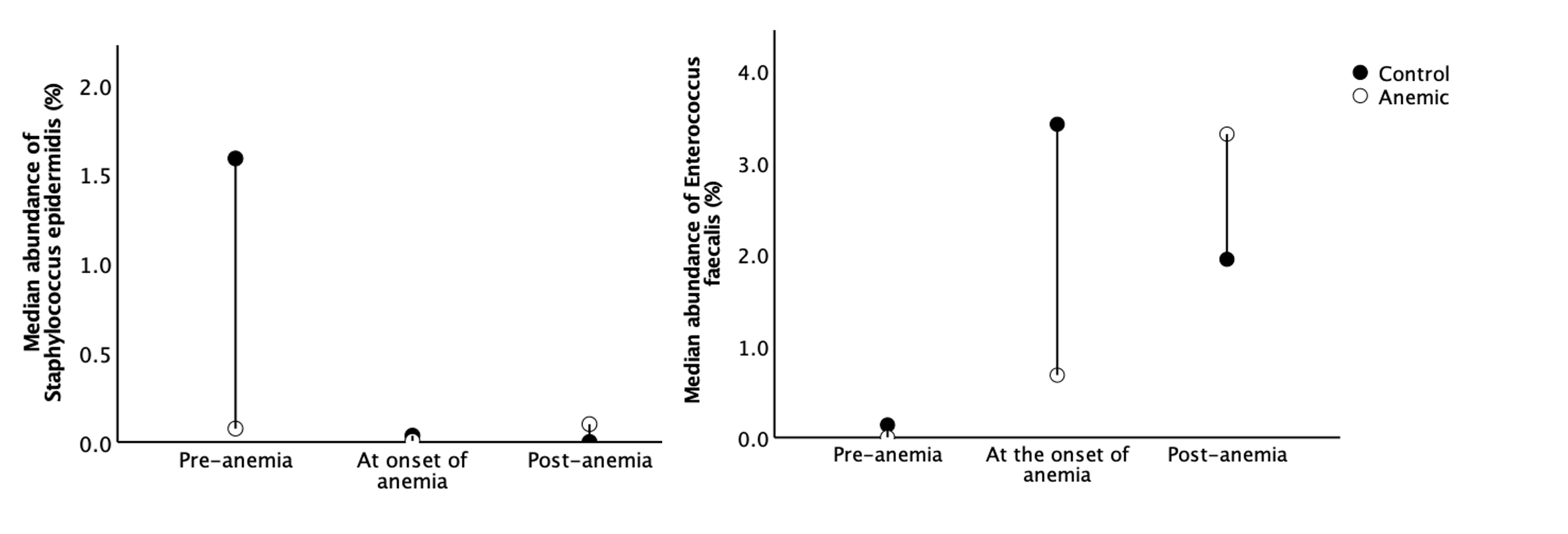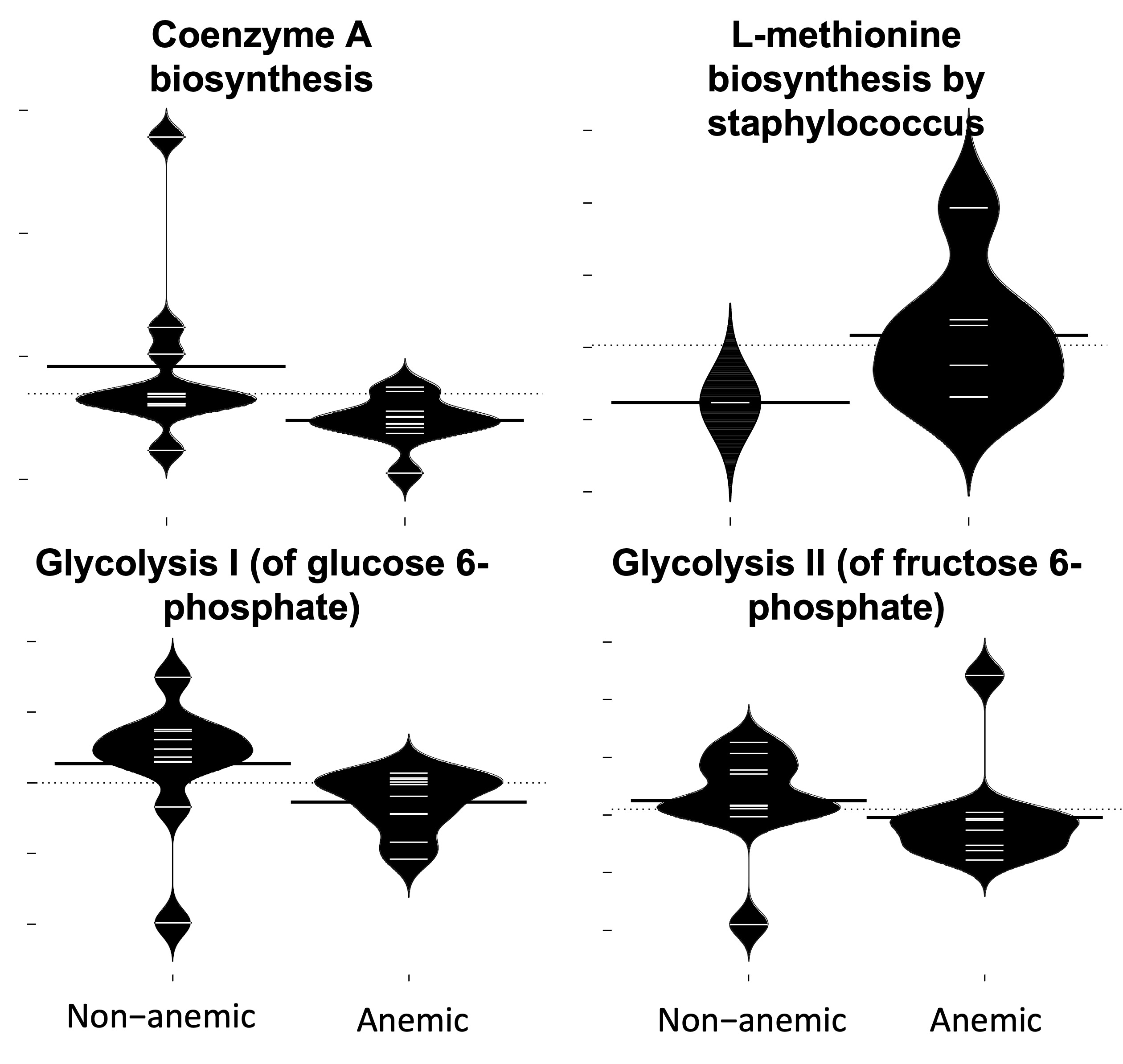Neonatal GI Physiology & NEC
Category: Abstract Submission
Neonatal GI Physiology & NEC II
503 - Severe Anemia Preceded Changes in Gut Microbiota in Very Low Birth Weight Infants
Monday, April 25, 2022
3:30 PM - 6:00 PM US MT
Poster Number: 503
Publication Number: 503.425
Publication Number: 503.425
Anujit Sarkar, University of South Florida, Tampa, FL, United States; justin Gibbons, University of South Florida, Tampa, FL, United States; Maureen E. Groer, UNIVERSITY OF SOUTH FLORIDA, Tampa, FL, United States; Thao Ho, University of South Florida, Riverview, FL, United States
- TH
Tina Ho, DO (she/her/hers)
Associate Professor
University of South Florida
Tampa, Florida, United States
Presenting Author(s)
Background: Intestinal injuries in preterm infants are common, multifactorial, and unpredictable and they can lead to short-term and long-term morbidities and even death. Anemia is one clinically controllable factor that has been associated with intestinal injuries. Anemia correlates with INF-γ, a pro-inflammatory cytokine, in very low birth weight (VLBW) infants. VLBW infants who developed anemia have intestinal γ-proteobacteria dominant microbiota but the temporal relationship between anemia and microbiota is unknown.
Objective: Our study aimed to delineate the timing of changes in bacterial composition and functional potential in relation to the onset of severe anemia in VLBW infants.
Design/Methods: This is a case control longitudinal study of 10 VLBW infants who developed severe anemia (Hct < 25%) vs 10 control infants with matched birth gestational age (GA) and weight (BW). The anemic infants had three stool samples collected prior, at the onset, and after the onset of anemia and the control infants had three stool samples collected with matched postnatal age. All stool samples had a matched Hct level at the time of stool collection. Stool metagenome sequencing was performed to identify bacterial species composition and functional potential. Random forest was utilized for feature selection in relation to the onset of anemia.
Results: There were no significant difference between the mean birth GA and BW, postnatal age at three stool collections, the Hct level prior to the onset of anemia, and hospital length of stay between the two groups. Hct levels were significantly lower at the onset and after the onset of anemia in the anemic group compared to the control group. Enterococcus faecalis and Staphylococcus epidermidis increased after the onset of anemia in the anemic group as they decreased in the control group (Figure 1). The anemic group had lower potential for glycolysis and coenzyme A biosynthesis and higher potential for L-Methionine biosynthesis by staphylococcal species than the control group (Figure 2). When the relationship between bacterial abundance and metabolic pathways was analyzed, the growth of Lactobacilli negatively correlated with guanosine ribonucleotides de novo biosynthesis by Enterococcus faecalis.Conclusion(s): As preterm infants developing severe anemia, their gut microbiota succession differs in bacterial species composition and functional potential compared to infants without anemia. These findings may explain the increased risk of intestinal injuries associated with severe anemia in preterm infants.
Bacterial Abundance Over Time in Anemic and Control Groups The abundances of staphylococcus epidermidis (left) and enterococcus faecalis (right) increased after the onset of anemia in the anemic group while they decreased in the control group at the matched time point.
The abundances of staphylococcus epidermidis (left) and enterococcus faecalis (right) increased after the onset of anemia in the anemic group while they decreased in the control group at the matched time point.
The Differences in Bacterial Functional Potential by Random Forest Gut bacteria from anemic preterm infants had lower functional potential in Coenzyme A biosynthesis and Glycolysis and higher functional potential in L-methionine biosynthesis by staphylococcal species than the gut bacteria in the control preterm infants.
Gut bacteria from anemic preterm infants had lower functional potential in Coenzyme A biosynthesis and Glycolysis and higher functional potential in L-methionine biosynthesis by staphylococcal species than the gut bacteria in the control preterm infants.
Objective: Our study aimed to delineate the timing of changes in bacterial composition and functional potential in relation to the onset of severe anemia in VLBW infants.
Design/Methods: This is a case control longitudinal study of 10 VLBW infants who developed severe anemia (Hct < 25%) vs 10 control infants with matched birth gestational age (GA) and weight (BW). The anemic infants had three stool samples collected prior, at the onset, and after the onset of anemia and the control infants had three stool samples collected with matched postnatal age. All stool samples had a matched Hct level at the time of stool collection. Stool metagenome sequencing was performed to identify bacterial species composition and functional potential. Random forest was utilized for feature selection in relation to the onset of anemia.
Results: There were no significant difference between the mean birth GA and BW, postnatal age at three stool collections, the Hct level prior to the onset of anemia, and hospital length of stay between the two groups. Hct levels were significantly lower at the onset and after the onset of anemia in the anemic group compared to the control group. Enterococcus faecalis and Staphylococcus epidermidis increased after the onset of anemia in the anemic group as they decreased in the control group (Figure 1). The anemic group had lower potential for glycolysis and coenzyme A biosynthesis and higher potential for L-Methionine biosynthesis by staphylococcal species than the control group (Figure 2). When the relationship between bacterial abundance and metabolic pathways was analyzed, the growth of Lactobacilli negatively correlated with guanosine ribonucleotides de novo biosynthesis by Enterococcus faecalis.Conclusion(s): As preterm infants developing severe anemia, their gut microbiota succession differs in bacterial species composition and functional potential compared to infants without anemia. These findings may explain the increased risk of intestinal injuries associated with severe anemia in preterm infants.
Bacterial Abundance Over Time in Anemic and Control Groups
 The abundances of staphylococcus epidermidis (left) and enterococcus faecalis (right) increased after the onset of anemia in the anemic group while they decreased in the control group at the matched time point.
The abundances of staphylococcus epidermidis (left) and enterococcus faecalis (right) increased after the onset of anemia in the anemic group while they decreased in the control group at the matched time point.The Differences in Bacterial Functional Potential by Random Forest
 Gut bacteria from anemic preterm infants had lower functional potential in Coenzyme A biosynthesis and Glycolysis and higher functional potential in L-methionine biosynthesis by staphylococcal species than the gut bacteria in the control preterm infants.
Gut bacteria from anemic preterm infants had lower functional potential in Coenzyme A biosynthesis and Glycolysis and higher functional potential in L-methionine biosynthesis by staphylococcal species than the gut bacteria in the control preterm infants.